2020: The Spring That Never Was
and Summer through My Window, no Place to Go
Marcy Petrini
December, 2020
Here is the scarf:
2020: The Spring That Never Was
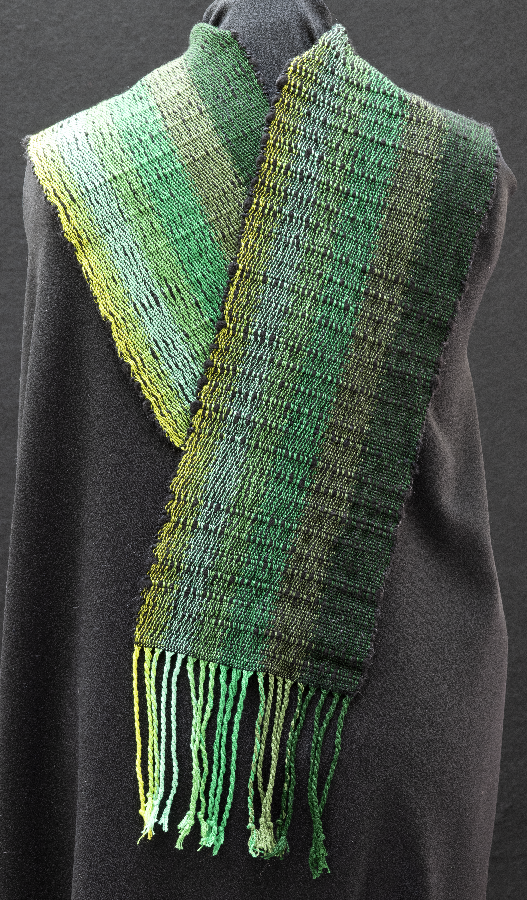
No, it’s not very “pretty”, but neither are the deaths of nearly 120,000 Americans for whom spring never was.
Spring comes early to Mississippi. The yellow-green pine pollens blanket the neighborhood: the ground, cars, roofs. The first spring rain washes out the pollens and gives way to more greens, bright at first, then turning darker. But in my mind that green became darker and darker as spring progressed. Dark army green. After all, this is a war we are fighting against this virus.
Yes, there are the dumb deaths: “It’s just a little cold”, which it is, until it isn’t.
Or the foolish deaths: “Let’s have a covid party, that way we can get infected and then go on with the rest of our lives.” Except the virus decides whether there is a “rest of your life.”
But I am saddened by the death of those who caught the virus early on, before we knew how infectious it can be before symptoms, or even without; before we knew that masks and social distancing can help.
And my heart does to the elderly and the disabled who lived in facilities where the caring and respite turned into death row. Or the grandma whose grandson thought “it is just a little cold.”
But most of all my heart is broken by the deaths of the health care givers and first responders who died helping others, sometimes with little protection, knowing the danger but choosing to do what was right for their patients. And made the ultimate sacrifice.
So I turned to my weaving. I envisioned a green scarf with progressively darker greens. Not much blending, deaths marches on in a linear way.
I wanted the fabric to be two sided, but not overwhelming so. I thought a 2/1 twill would provide it. The 10/2 cottons from Lunatic Fringe offer a variety of greens; I used 7 in the warp, sett at 30 epi, and planned on 10/2 black for weft. The drawdown is below (with a reduced number of greens).
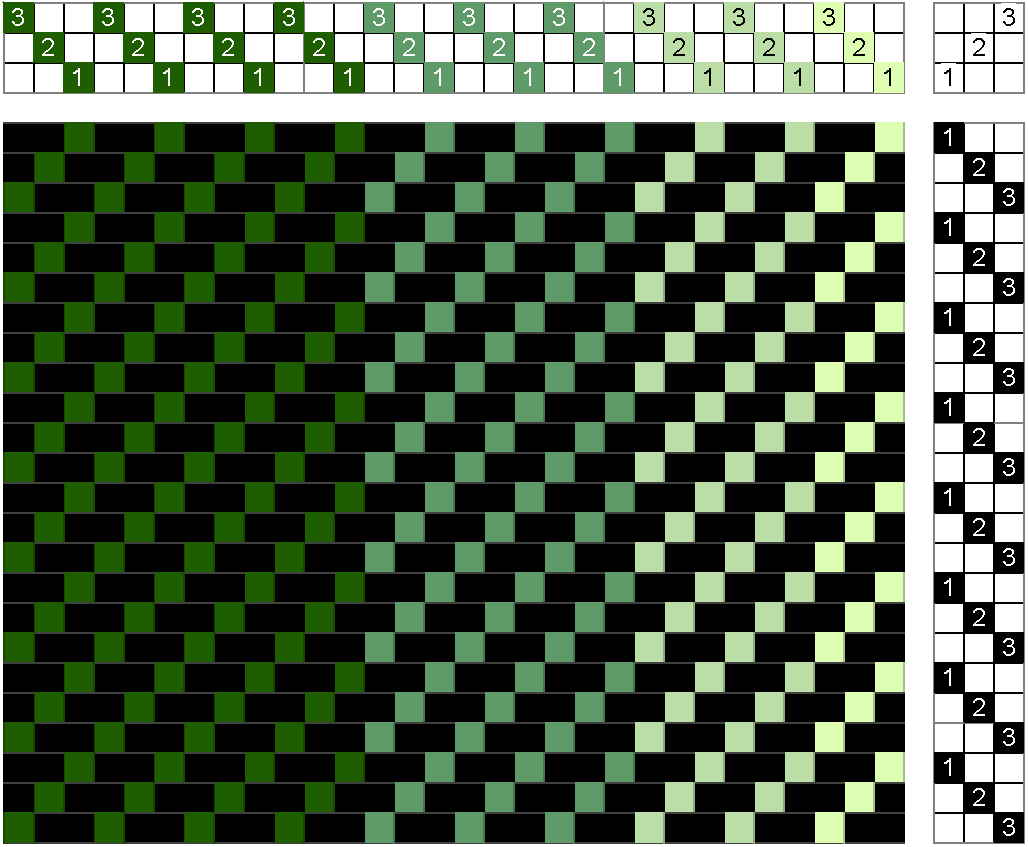
I hadn’t woven a 2/1 twill in a long time; more recently I wove a 3/1 twill, but it was a while back, too. My recollection, however, was that the edges of such an unbalanced fabric can curl up. I thought I could prevent it by threading a selvage, using the 4th shaft that was not part of the twill; I could thread a pseudo basket weave, which would still need floating selvages, but provide some stability and prevent the curling. The drawdown is shown below.

I began to weave, but the 10/2 black just didn’t match the idea I had in mind. I decided there wasn’t enough texture. I tried a couple different wefts, and finally I found on my shelf the Universal Yarn “Bamboo Bloom Lights out”, black, thick & thin, 48% bamboo, 44% wool, 8% acrylic. The thick and thin provided the texture.
I also didn’t like the pseudo basket weave at the edge, probably because the sett of 30 epi was too close, but also the intersections didn’t look right with the bamboo blend. So, I took the 6 threads on each side and rethreaded and re-sleyed them for the twill. I was finally ready to go.
It’s not unusual for me, if I am weaving with something specific in mind, to rework the project as I go. I change wefts often, I re-sley if need be. Sometimes changing the weft results in needing a different sett. I have also re-threaded if I haven’t liked the pattern after all. I think of my warp as a canvas, it does not need to be static.
The scarf is a bit heavy but it has some drape, certainly less than my usual scarves. But that’s ok, this is one scarf I don’t plan on wearing.
Here are the close ups of the fabric:
 |
 |
On the left is the top as I was weaving; because the floats are only over 2 threads, and the sett is rather dense, what we may expect as the weft-dominant side is not. On the right is the bottom as I was weaving, warp dominant, with the weft poking through in the thick parts.
At the end of a project, I always ask myself: if I were to do this again, what would I do differently. In this case, I think the 3/1 twill would have made the weft-dominant and warp dominant more obvious. And the thick and thin yarn would probably have prevented the curling anyway. Each project offers some learning.
As macabre as it may sound, while I was weaving, I thought of all the dead underneath the earth, looking up to our green spring. They are gone. We could have prevented a lot of those deaths. We didn’t.
Here is the scarf:
2020: Summer Through My Window, No Place to Go
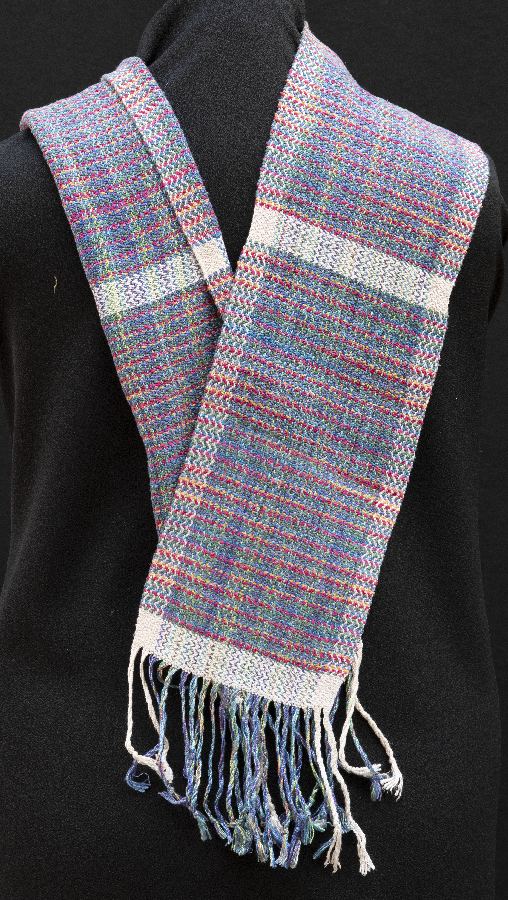
Memorial Day weekend is the unofficial beginning of summer and what a better way to start than a Mississippi Symphony Orchestra concert on the grounds in front of the Vicksburg Military Park. But in 2020, cancelled.
There is no more relaxing way to spend summer evenings than at the ballpark, cheering our local team, the Mississippi Braves. But in 2020, no minor league baseball.
Wherever I go, my travel journal goes with me. This year it stayed in the drawer. No Convergence®, no travel, not even a little excursion.
But I have my window, a great view of the backyard from my studio.
Really, I can’t complain. I have my health, good food, shelter, work that keeps me busy and happy, and the good companionship of my husband. I have so much while others have nothing.
In the evenings we sit in the patio right outside the studio window, but during the day, I watch from inside. It’s hot and humid outside, so Mother Nature’s colors are muted: the golden sun filtering through the greens of the trees and plants; the blue of the jays as they fly around looking for their favorite seed, the blackbirds’ feathers so shiny that they looks purple.
And the reds: the red of the hummingbirds as they flutter by the feeder, the crimson of the male cardinals looking for a mate; the showy reddish pink of the throats of the lizards as they scurry along the small wall in front of the studio, the bright red of the woodpecker on the tree across the yard, and the burgundy of the fruits of the two cacti that Terry rescued when the local Mexican restaurant closed.
I love those reds.
But then I think of covid red.
How did covid become red? The now familiar picture of the round virus with spikes comes from electron micrographs, which are in black and white, not red.
Did an artist render it red early on to alert of danger?
Did a pulmonologist describe the red inflammation caused by the virus in the damaged lungs of his patient?
Did the cardiologist fear the red clots that could kill her patients just as they seemed to turn the corner?
I don’t know, but red it is.
I try to look at the beauty and not think of that red.
So, I decided to weave it.
I chose some 10/2 Tencel left over from past Convergences®, by Just Our Yarn, Water and Fire, alternating with Wood Violet in the warp, sett at 24 epi.
For the structure, I wanted a twill, but I wanted the floats to be of different lengths and not in the same direction, so I used an undulating twill threading with a pointed twill treadling. At that close scale, I knew the twill would not show, but my plan was for the twill floats and their directions, not the actual pattern.
That’s for the view. My window frames are painted off white, so I needed an off white border. I found some shiny silk in my stash, which I set at 16 epi, 1” on each side, threaded as a straight draw. Below is the drawdown of one repeat of the twill with the two edges. I used floating selvages since a pointed twill treadling doesn’t catch every warp thread.
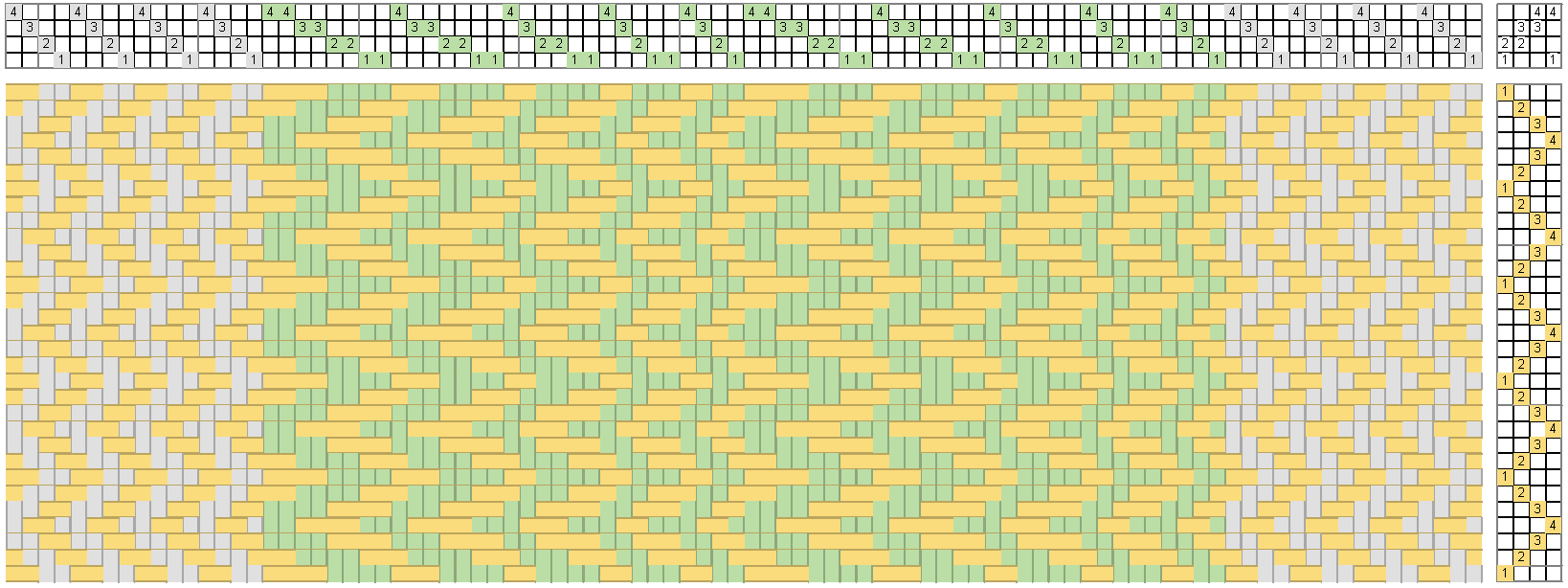
The plan was to weave 1” with the off-white silk, 12” with a weft yet-to-be-determined, and another 1” of off-white silk to make the “windows.”
Where the off-white silk weft crossed the warp in the middle, the colors of the warp show up, but that is ok, my window frames are shiny, and they reflect the outside colors.
After the 1” of off-white silk, I started trying various colors of 10/2 Tencel and 20/2 silk, which are close enough in size to work well with the 10/2 Tencel warp.
Nothing worked. The colors blended too much.
I should have thought that there would be optical blending, with so many colors and relatively small threads, especially from a bit of a distance, as we would be looking at a scarf being worn. Normally our brains first detect the edge of a shape, then the color is filled in; this is called the edge effect. But if we have poor resolution of the shapes, as with small threads, the brain cannot distinguish the shapes and it blends the colors. This is a useful technique when we want to work it that way – we can put red and blue together and the piece will look purple from the optical blending. But I wanted individual colors to appear and not blend, so using the same size weft on a multicolor warp did not work well. Back to the yarn shelf.
I found a matt 100% silk hand-dyed by Margaret Pittman of Heritage Yarns who has sadly now retired. Her colors have always been wonderful. The yarn has reds, greens, blue, purples, and gold, variegated, which Margaret called Spring at Rocky Springs (a real place in Mississippi), but those are the colors in my yard. There were 16 picks per inch once I started weaving, which made the scarf more weft dominant.
Here is a close up of the “window”:
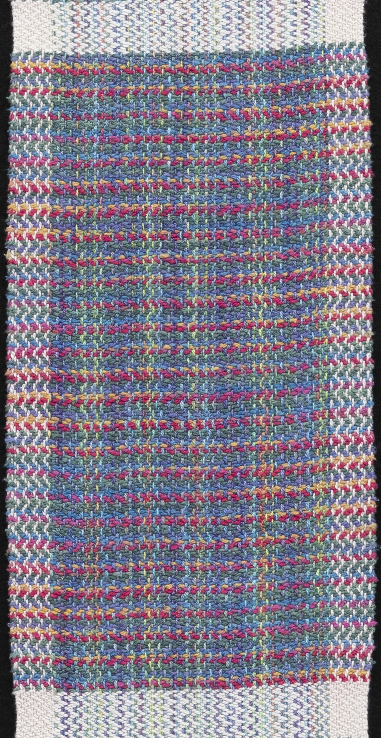
Despite being weft-dominant, the scarf drapes well, silk, even matt provides the drape.
Just as I was getting used to the new – hopefully temporary – normal, autumn rolled around with more destruction. When will this end?
Stay well and safe – and happy weaving!
Please email comments and questions to
